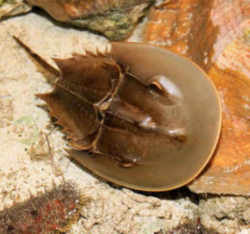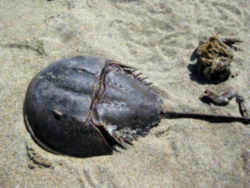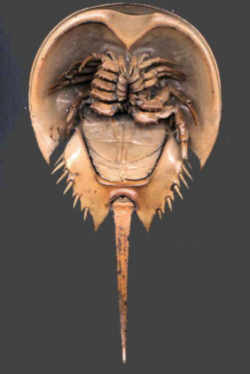What Is The State Marine Animal Of Delaware?

State Mammals

Delaware Symbols

Delaware Symbols
Beverage, Bird, Problems, Butterfly, Colors, Dessert, Fish, Flag, Floral Emblem, Bloom, Fossil, Fruit, Herb, Macroinvertebrate, Marine Animal, Mineral, Motto, Nickname, Quarter, Seal, Beat out, Soil, Song, Star, Tree, Wild fauna Animal
State Symbols Listing

- State Resources
- » 50 States
- » State Symbols
- » Mammals
Delaware State Marine Animal
Horseshoe Crab

(Limulus polyphemus)
Adopted on June 25, 2002 .
Recognizing its great importance and value, the horseshoe crab was designated equally Delaware's official marine animal on June 25, 2002. These invertebrates contain a compound, limulus amebocyte lysate (LAL), that is used to detect bacterial poisons in certain medications, vaccines and medical devices. Chitin, a natural polymer institute in the horseshoe crab'south crush, is used to make bandages. The horseshoe crab is used in vision studies, because their complex center structure is similar to the man eye. It is the principal food source for over a million shore birds. Delaware Bay is the dwelling to more horseshoe crabs than any other place in the world.
Thee horseshoe crabs contain a chemical compound, fiftyimulus amebocyte lysante (LAL), that is used to discover bacterial poisons in certain medications, vaccines and medical devices. Chitin, a natural polymer institute in the horseshoe crab'due south shell, is used to make bandages. The crab is used in vision studies because their complex middle construction is like to the human middle. It is the master food source for over a million shore birds. Delaware Bay is the abode to more than horseshoe crabs than any other identify in the world.

Despite their name, information technology is more closely related to spiders, ticks, and scorpions than to crabs, horseshoe crabs are not true crabs. Unlike true crabs, which have 2 pairs of antennae, a pair of jaws, and five pairs of legs, horseshoe crabs lack antennae and jaws, and they accept seven pairs of legs, including a pair of chelicerae. Chelicerae are appendages like to those used past spiders and scorpions for grasping and burdensome. In addition, horseshoe crabs have book lungs, like to spiders and unlike from crabs, which have gills. Thus, horseshoe crabs are more closely related to spiders and scorpions than they are to other crabs. Their carapace is divided into three sections: the inductive portion is the prosoma; the middle department is the opithosoma; and the "tail" is called the telson. Horseshoe crabs have two pairs of eyes located on the prosoma: ane anterior set up of simple eyes and one set of lateral chemical compound eyes like to those of insects. In addition, they possess a series of photoreceptors (lite-sensitive organs) on the opithosoma and telson.
Habitat and Biological science of the Horseshoe Crab
Developed horseshoe crabs are benthic animals inhabiting both shallow estuarine areas and offshore habitats near the continental shelf. The range of the horseshoe crab extends from northern Maine to the Yucatan Peninsula. They are particularly arable in Delaware Bay, the center of their distribution, and in coastal areas between Virginia and New Jersey. Different populations of horseshoe crabs are idea to inhabit every major estuary forth the Atlantic coast. Each population can be differentiated from the others based on size of adult crabs, the color of their carapace, and pigments present in their eyes.

Early on each leap, every bit estuarine water temperature approaches 20?C, developed horseshoe crabs motility inshore to seek suitable spawning habitat. Throughout the bound, females with males attached to their carapace follow flooding tides high onto the beach, where they excavate nests and eolith thousands of eggs. During mating, the male grasps the female's carapace and fertilizes her eggs as she deposits them in the nest cavity. Oftentimes, other unattached "satellite" males may also fertilize some of the eggs. Mating and nesting coincide with loftier tides. Nests are excavated by the female on the intertidal zone of sandy beaches, and eggs are laid in clusters Spawning activity is particularly heavy during nighttime spring tides. Females nest several times per season, usually returning to deposit more eggs on subsequent high tides. After approximately two weeks, depending on temperature, wet and oxygen levels, larval horseshoe crabs emerge from the nest. Larval Limulus are semi-planktonic for almost 3 weeks before their transition to a benthic existence. They and so settle to the lesser and assume a benthic being, typically spending their outset two years in intertidal sand flat habitats near beaches where they were spawned. Adults render to deeper estuary bays and continental shelf waters afterward the convenance season. Horseshoe venereal are long-lived animals; after attaining sexual maturity, in nine to 12 years, they may live for another 10 years or more. Like other arthropods, horseshoe crabs must molt in order to abound. As the crab ages, more and more time passes between molts, with 16 to 19 molts occurring before a crab becomes mature, stops growing, and switches energy expenditure to reproduction. Adult horseshoe crabs feed on a multifariousness of bottom-dwelling organisms including marine worms, shellfish, and decomposable animate being matter. The larvae and juvenile stages are preyed upon by many species of fish and birds, and developed horseshoe crabs are known to be a nutrient item for the threatened loggerhead sea turtle, Caretta caretta.
Horseshoe Crab Significance
Horseshoe venereal are an important species, both commercially and ecologically. They are currently the chief bait used in the whelk and eel fisheries forth the Atlantic coast. Crabs in the ACE Basin were once harvested in small numbers for this purpose. However, the Country of South Carolina prohibited this activity in 1991. Horseshoe crabs are also harvested for use in biomedicine. A clotting agent in the crab'southward claret, known as Limulus Amoebocyte Lysate (LAL), is used to detect microbial pathogens in medical intravenous fluids, injectable drugs, and supplies. Biomedical companies purchase big crabs, which are harvested by trawlers or by hand from spawning beaches. The venereal are transported to the LAL production facility, bled, and then transported dorsum to the general harvest vicinity and released live. LAL is currently used worldwide every bit the standard (FDA required) test for microbial contamination in injectable pharmaceutical products. Horseshoe crabs have also been used in eye research and the development of wound dressings and surgical sutures. Ecologically, horseshoe crabs are an important component of coastal nutrient webs. In particular, horseshoe crab eggs are the chief source of fatty for at to the lowest degree 20 species of migratory shore birds. Larval and juvenile crabs are likewise nutrient for many species of fish and invertebrates, while adult crabs are favored by loggerhead sea turtles and sharks. In addition, horseshoe crabs have been shown to be a controlling factor in benthic species composition through their feeding activities.
Resource managers are concerned that the health of horseshoe crab populations along the northeastern coast of the United States is threatened due to overharvest. New fishery regulations are existence considered, and the National Marine Fisheries Service is currently developing a horseshoe crab fishery direction plan for the E Coast. Contempo studies (summer 1997) advise that betwixt x% and twenty% of crabs harvested for LAL production do not survive (even though the Food and Drug Administration mandates that they be returned to the h2o live). In South Carolina, the harvest of horseshoe crabs is limited to the LAL industry, and a permit has been required since 1991. This species is not currently listed as threatened nor endangered.
Delaware Law
The law designating the Horseshoe crab as the official Delaware state marine animal. is found in the Delaware Code, Title 29, Chapter iii, Section 318.
Chapter 326
FORMERLY
Business firm Bill NO. 448
AN Human action TO AMEND Championship 29 OF THE DELAWARE CODE RELATING TO THE OFFICIAL State MARINE ANIMAL.
BE Information technology ENACTED Past THE General Associates OF THE STATE OF DELAWARE :
WHEREAS, horseshoe crabs are 500 million year quondam creatures; and
WHEREAS, horseshoe crabs incorporate a compound, limulus amebocyte lysate (LAL) that is used to notice bacterial poisons in certain medications, vaccines and medical devices; and
WHEREAS, chitin from the shell of the horseshoe crab is used to make bandages; and
WHEREAS, the horseshoe crab is used in vision studies because their circuitous heart structure is like to the man eye; and
WHEREAS, the horseshoe crab is the master food source for over a million shore birds; and
WHEREAS, these wonderful marine animals are becoming extremely deficient in Delaware, experiencing a drop in population from i,200,000 in 1990 to 200,000 in 1995; and
WHEREAS, the Delaware Bay remains the home to more than horseshoe crabs than any other identify in the globe; and
WHEREAS, Delaware is proud to exist the home of such of import marine animals.
Exist It ENACTED By THE General Associates OF THE STATE OF DELAWARE:
Section one. Amend Chapter three, Title 29 of the Delaware Code by adding a new §318 thereto to read as follows:
"§318. State marine fauna.
The official State marine animal is the horseshoe crab."
Section 2. This Act shall accept effect immediately upon enactment into constabulary.
Canonical June 25, 2002
Taxonomic Bureaucracy: Horseshoe Crab
Kingdom: Animalia
Phylum: Arthropoda
Subphylum: Chelicerata
Class: Merostomata
Order: Xiphosura
Family unit: Limulidae
Genus: Limulus - O. F. K?ler, 1785
Species: L. polyphemus
Country Mammals

Mammals are vertebrates (backboned animals) that feed their young on female parent'south milk.
Source: https://www.ereferencedesk.com/resources/state-mammal/delaware-marine-animal.html
Posted by: mercerciat1967.blogspot.com

0 Response to "What Is The State Marine Animal Of Delaware?"
Post a Comment